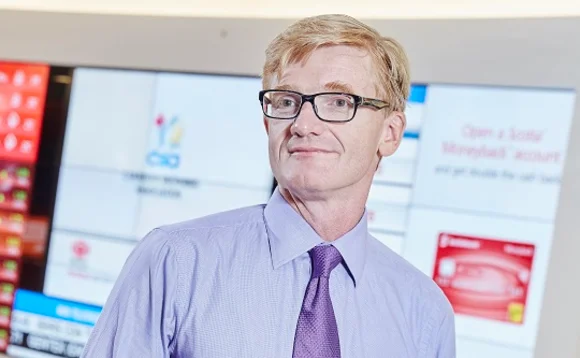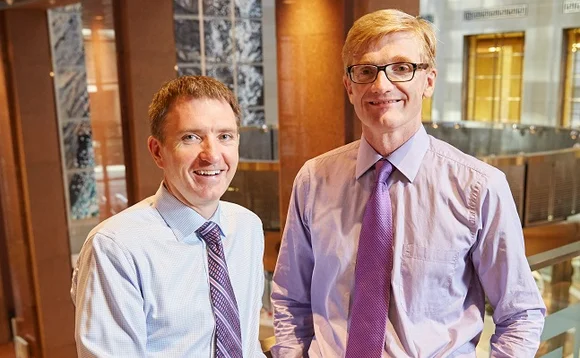Tag Team: McNamara and Zerbs Work Towards Common Tech Goals at Scotiabank
The two new heads of Scotiabank talk about the Toronto-based bank's latest projects and how they effectively work together.







Kyle McNamara and Michael Zerbs, who were recently named co-heads of information technology at Scotiabank, talk with Dan DeFrancesco about dividing responsibilities, working together and handling all the issues that come with running the technology behind one of the biggest banks in Canada. It's a true team effort.
Plenty of decisions needed to be made when the news first came down that Kyle McNamara and Michael Zerbs would be taking over as co-heads of information technology at Scotiabank. How would the responsibilities be divided between the two? Who would attend which meetings? How could they work together to effectively get across a consistent message to the entire technology division? How could they avoid becoming a two-headed monster?
An early sign of how successful their first few months would be came when they faced a decision that wasn't related to their job duties, per se.
The previous head of technology, Kim McKenzie, retired on June 1, naturally leaving behind only one office. A decision needed to be made about where McNamara and Zerbs would each be working going forward.
The two could have stomped feet-as some executives have been known to do-until they were each given new offices. Or they could have forced the bank to divide McKenzie's office into two separate ones the exact same size.
"We honestly believe technology is going to define banking for the next five years, so it's incredibly and strategically important that putting two individuals in charge now allows us to diversify our areas of focus." Kyle McNamara
Instead, the pair chose to take a different route, one that's indicative of how they work together.
McNamara and Zerbs decided to share McKenzie's old office. No dividing walls, no border lines, just the co-heads of technology tackling the latest technology-related issues of a bank with over $693 billion ($837 billion CAD) in assets under management as of April 30.
Zerbs admits that sharing an office isn't something traditionally seen in banks. And while initially there were plenty of visits from curious colleagues, there was no cause for concern.
"It became a little bit of the interesting destination. People would come by and look into the office and say, ‘Hey, how's it going?' And the truth is, it's going great, because if you have the aspiration to really jointly run a function, it will go great," Zerbs says. "Super tight communication and the ability to turn your chair 90 degrees and say, ‘Hey Kyle, what do you think about this?' ... that's so important."
Table for Two
As technology co-heads, a delicate balance is required of McNamara and Zerbs. While they both need to be informed on current issues at the bank, they also can't expect to attend every meeting together because then, as Zerbs puts it, what would be the point of having co-heads?
The solution is a split of responsibilities into two divisions. McNamara handles the business systems side of things, being the primary point of contact for the business-focused products and working with the firm's Canadian banking, international banking and global banking and markets business lines, in addition to banking subsidiary, Tangerine.
Zerbs, meanwhile, is tasked with taking on the enterprise technology, focusing on growing and improving Scotiabank's internal systems, platforms and applications.
"We honestly believe technology is going to define banking for the next five years, so it's incredibly and strategically important that putting two individuals in charge now allows us to diversify our areas of focus," McNamara says. "It also helps drive cultural changes that we're looking for within the bank, because we can divide and conquer."
Having co-heads doesn't just help with the handling of a bank that has more than 86,000 employees, more than half of which work internationally. It's also about the depth of the conversations they're required to have.
Zerbs points out that when talking with colleagues who run their respective divisions, the conversations tend to go beyond the typical governance chats senior executives are usually limited to. Often, specific customer use-cases are brought up and discussed, requiring Zerbs and McNamara to have a deep knowledge of how each aspect of the business operates and what some of the key customer-facing needs are.
McNamara and Zerbs are no strangers to these types of talks. McNamara has over 15 years' experience at Scotiabank and is well-versed in how things work at the firm.
Zerbs, meanwhile, brings a different perspective due to his decades of experience working at risk management software provider Algorithmics. The business he now deals with might be internal, but the issues-identifying what needs to be built, making sure the technology is seen as a joint responsibility, keeping the end customer in mind at all times-are the same he's handled for years.
"For the magnitude of the task, you really need two fully empowered executives, given the change that we're talking about, the need to focus on both operational excellence on a day-to-day basis and to keep running the bank, as well as investing in a whole bunch of large change initiatives and making sure that the business stays engaged every step of the way," McNamara says. "I think that's something that really requires top-of-house attention, and we wouldn't do these initiatives justice if it didn't have that whole structure that we have."
Piloting Hadoop
One of those changes was sparked by the Basel Committee on Banking Supervision's principles for effective data aggregation and risk reporting, also known as BCBS 239. The regulation, with which global systemically important banks (G-Sibs) must comply by January 2016, requires banks to be able to aggregate and report their risk data across their entire enterprise.
As at many banks, Zerbs says BCBS 239 triggered a fundamental rethink at Scotiabank about how to bring data together to meet the requirements of the regulation. The main goal was to develop a solution that would be scalable and repeatable in other aspects of the organization.
What Zerbs says Scotiabank wasn't interested in was developing a solution that would need to be overhauled over and over again.
"You start a project where you extract the data in exactly the form that was required. Time goes by. By the time you're done, the business says, ‘By the way, now that I think about it, I need another five data attributes.' And you're saying, ‘Well you should have told me earlier, because now it's a six-month change project and it's going to cost you more, on the magnitude of hundreds of thousands of dollars,'" says Zerbs. "That's the kind of vicious circle that repeats itself too often. So we thought: How do we avoid that?"
Apache Hadoop seemed like the obvious choice, according to Zerbs. At the time, though, the bank didn't have a lot of experience with the big data application. Zerbs says Scotia decided to use another pressing regulation ─ Volcker Rule compliance ─ as a test case for its first product application on the Hadoop platform.
The Volker Rule, part of the US Dodd-Frank Act, requires banks to delineate client-related trading from proprietary trading. Regulators look at several metrics to decipher whether something is considered proprietary or client-related. Client metrics are also looked at, including how much inventory needs to be held to satisfy client demands in areas the firm is considered a market-maker.
Because Scotia's prop-trading activity was already fairly small relative to its overall size, the project was deemed more manageable than jumping in with BCBS 239. And due to Volcker having what Zerbs describes as a "fuzzy set of requirements," the scalability and reusability of a big data solution seemed like the perfect option and chance to test the waters in an area that Scotiabank lacked experience.
More Than a Catalyst
The bank had less than six months to go from conceptualization to initial production to meet the first deadline, which passed on July 21. Zerbs says it's an example of bringing together the customer, risk, and technology focus all at once to create a solution that has multiple benefits to the entire organization.
There will be more of these types of changes, as McNamara and Zerbs finish settling in and start initiating projects throughout the bank. The pair says being tasked with serving as a catalyst is eased by the fact that Scotia gives so much support to the IT department. President and CEO Brian Porter made a comment at the firm's general shareholders meeting in April that Scotiabank is really a technology company in financial services. And when it comes to multiplying technology's bandwidth, two technologists are certainly better than one.
"Right across all the executive ranks within the bank, we're spending a tremendous amount of time with the different areas to ensure that their business strategies are factored into our technology priorities," McNamara says. "It's helping us execute and implement the strategies that we've spent the last couple of months defining."
In Their Blood
While co-headed functions are not unusual in financial services, they are still far from the norm. But doing something just a little unorthodox doesn't necessarily mean it's wrong, especially in technology.
That type of thinking is in McNamara's and Zerbs' blood, as both of their fathers were involved in tech projects that were considered new, cutting edge and different for their time.
McNamara's dad worked for Canada Trust, which was eventually acquired by TD Bank, on the firm's first MasterCard and automated banking machines-Canada's version of the ATM. Exposure to that type of innovative technology at an early age got McNamara interested in a similar career.
Zerbs, who is Austrian, cites his father's career guiding economic policy for one of the Alpine country's provincial governments, which stressed grassroots campaigns to help technology companies grow and succeed. The concept was an inspiration for the first technology incubators and digital garages of the pre-digital age, and got the younger Zerbs thinking, too.
As a result, he wrote a paper for one of his university degrees about how to create successful technology incubators and leverage their momentum, which served as the tipping point that led him into the world of IT and financial services.
"For me, that created a deep interest in my early 20s around technology," Zerbs says. "So when I came over to Canada, and saw the opportunities to build software and finance in an entrepreneurial context here, I was already sold."
Opposite Worlds
Still, while sharing an early awareness of the benefits of technology, McNamara and Zerbs come from very different backgrounds.
McNamara was born and raised in London, Ontario, a moderately sized city only two hours southwest of Toronto. After graduating from the University of Western Ontario, McNamara spent a few years at various financial services firms, in addition to two years at Canadian telecom companies, before landing at Scotiabank in 1999.
From there, he would climb the ranks at the Toronto-based institution, starting in the small business division of Canadian banking, then moving to securities and operations, global wholesale services and wealth operations, and, most recently, operations and strategic projects in global risk management.
"I've had the opportunity to work in a number of different areas within the bank, intertwining all of the cool things that were happening and continued to happen on the banking side," McNamara says. "That kind of background-of being in and out of technology, related to technology but also with a breadth of experience of financial services-I think is very helpful."
Zerbs had a slightly longer trip, 4,300 miles across the Atlantic from Linz, in Upper Austria. A one-year stint at the University of Toronto to earn his master's in business administration with a concentration in finance was what originally brought him across the pond.
While at the university, Zerbs met Ron Dembo, a professor who was in the process of starting up a software company focusing on risk management. Despite "barely knowing how to spell risk management," as Zerbs puts it, he worked as the professor's research assistant for a couple of months. Eventually he was offered a job with the new firm, becoming employee number one of what would turn into Algorithmics.
"I worked my way through every single job possible," says Zerbs of his time at Algorithmics. "From going to the grocery store and buying coffee for the coffeemaker, to developing software, to consulting with clients, to managing implementations, to doing sales for a while where I essentially built up the European presence for the firm."
When the company was sold to Fitch Group in January 2005, Dembo retired and Zerbs took over running the firm. When the business was again sold in late 2011, this time to IBM, Zerbs stayed on for over two years to help with Algorithmics' integration into the technology giant before heading to Scotia in May 2014, where he first served as head of risk management IT and began working with McNamara.
"Seeing the strategic road that technology was going to play here, meaning support of technology as well as the cultural change around it, that was such a great opportunity," Zerbs says. "Every day at Scotia has lived up to my expectations in terms of what I hoped to do and what I would see."
Kyle McNamara Fundamental Data
Name: Kyle McNamara
Age: 44
Hometown: London, Ontario
Title: Co-head information technology, business systems
Education: Honors degree in actuarial science and economics from University of Western Ontario
Scotiabank Assets Under Management: $693.5 billion ($837 CAD) as of April 30
Hobbies: Running, sports
Michael Zerbs Fundamental Data
Name: Michael Zerbs
Age: 50
Hometown: Linz, Austria
Title: Co-head information technology, enterprise technology
Education: Master's of science in social and economic sciences in commerce from Vienna University of Economics and Business Administration; doctorate of philosophy in economics from Johannes Kepler Universität Linz; and a master's of business administration in finance from the University of Toronto
Hobbies: Skiing, road biking, reading, traveling
Only users who have a paid subscription or are part of a corporate subscription are able to print or copy content.
To access these options, along with all other subscription benefits, please contact info@waterstechnology.com or view our subscription options here: https://subscriptions.waterstechnology.com/subscribe
You are currently unable to print this content. Please contact info@waterstechnology.com to find out more.
You are currently unable to copy this content. Please contact info@waterstechnology.com to find out more.
Copyright Infopro Digital Limited. All rights reserved.
As outlined in our terms and conditions, https://www.infopro-digital.com/terms-and-conditions/subscriptions/ (point 2.4), printing is limited to a single copy.
If you would like to purchase additional rights please email info@waterstechnology.com
Copyright Infopro Digital Limited. All rights reserved.
You may share this content using our article tools. As outlined in our terms and conditions, https://www.infopro-digital.com/terms-and-conditions/subscriptions/ (clause 2.4), an Authorised User may only make one copy of the materials for their own personal use. You must also comply with the restrictions in clause 2.5.
If you would like to purchase additional rights please email info@waterstechnology.com
More on Emerging Technologies
‘The end of the beginning’: Brown Brothers Harriman re-invents itself
Voice of the CDO: Firms who want to use AI successfully better start with their metadata, says BBH’s Mike McGovern and Kevin Welch.
2026 will be the year agent armies awaken
Waters Wrap: Several AI experts have recently said that the next 12 months will see significant progress for agentic AI. Are capital markets firms ready for this shift from generative AI to agents?
Editor’s Picks: Our best from 2025
Anthony Malakian picks out 10 stories from the past 12 months that set the stage for the new year.
The next phase of AI in capital markets: from generative to agentic
A look at some of the more interesting projects involving advanced forms of AI from the past year.
Market data costs defy cyclicality
Trading firms continue to grapple with escalating market data costs. Can innovative solutions and strategic approaches bring relief?
As trading firms embrace AI, so do hackers
According to a Google cybersecurity report, cybercriminals are turning to AI to sharpen their attacks.
AI & data enablement: A looming reality or pipe dream?
Waters Wrap: The promise of AI and agents is massive, and real-world success stories are trickling out. But Anthony notes that firms still need to be hyper-focused on getting the data foundation correct before adding layers.
Waters Wavelength Ep. 343: Broadridge’s Jason Birmingham
This week, Jason Birmingham of Broadridge talks with Tony about the importance of fundamentals as technology rapidly evolves.








